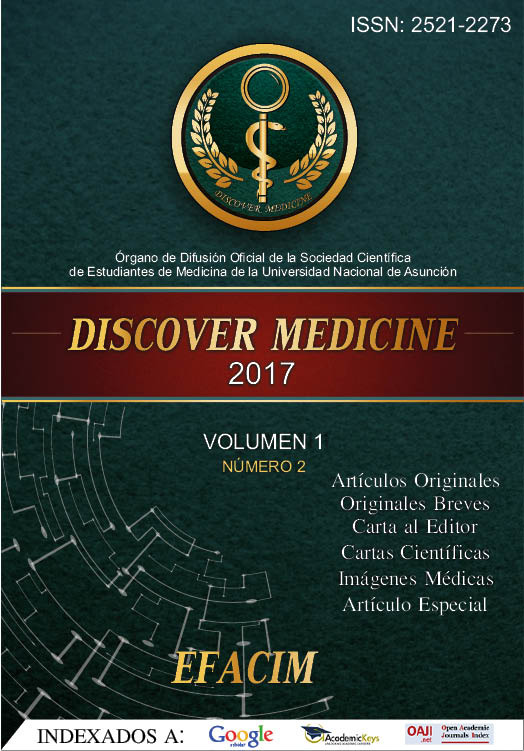Resumen
Introducción: A nivel internacional se ha sugerido que los valores de hemoglobina pueden ser estimados a partir de un tercio del valor del hematocrito (Hto⁄3=Hb). Sin embargo, varios estudios han indicado que la hemoglobina real (aquella obtenida por laboratorio) es significativamente diferente de la hemoglobina estimada por hematocrito. El objetivo de este trabajo es determinar la diferencia entre el valor de hemoglobina real y el valor estimado a partir del hematocrito en estudiantes de medicina de la Universidad Nacional de Asunción.
Métodos: El estudio fue observacional, analítico, prospectivo de corte transversal. El muestreo fue no probabilístico, de conveniencia. Se estudió a una población de 126 pacientes entre 18 y 25 años, cursantes del primer al tercer año de la carrera de Medicina y Cirugía de Facultad de Ciencias Médicas de la Universidad Nacional de Asunción.
Resultados: Los valores de hemoglobina estimada por hematocrito fueron en promedio superiores a los de la hemoglobina observada por laboratorio. La relación Hematocrito/Hemoglobina observada laboratorialmente fue 3,06±0,11. La diferencia entre los valores encontrados en la hemoglobina estimada y la observada fue no significativa.
Conclusión: La diferencia entre valores de hemoglobina real y los valores de hemoglobina estimada por hematocrito fue no significativa.
Citas
Tortora C, Garcia T, Buys MC. Valores de hematocrito y prevalencia de anemias en escolares Jujeño. Medicina (B. Aires). 2003;63:288–92.
Orrego L. Valores de hematocrito y de hemoglobina en deportistas evaluados en Instituto de Deportes de Medellín (Colombia). Acta Med Colomb. 2007;(70):196–205.
Echagüe G, Díaz V, Pistilli N, Méndez J, Ríos R, Nuñez D, et al. Valores hematológicos en donantes de bancos de sangre de Asunción, Paraguay. Mem. Inst. Investig. Cienc. Salud. 2003;2(1):49–56.
Flor KS, G LN, Cruz M. Valores de referencia hematológicos en población altoandina ecuatoriana. Rev Mex Patol Clin. 2008;55:207–15.
Flores-Torres J, Echeverría-Ortega M, Arria- Bohorquez M, Hidalgo G, Albano-Ramis C, Sanz R, et al. Por hematocrito y su importancia en el diagnóstico de anemia en población costera venezolana : análisis del segundo estudio nacional de crecimiento y desarrollo (SENACREDH). Rev Peru Med Exp Salud Publica. 2011;28(1):47–53.
Forrellat-Barrios M, Hernandez-Ramírez P, Fernandez-Delgado N, Pita-Rodríguez G. ¿Se cumple siempre la relación hemoglobina- hematocrito?. Rev Cuba Hematol Inmunol y Hemoter. 2010;26(4):359–61.
Gómez de la Torre Petrell JC, Bustinza Linares E, Huarachi A. Valores de referencia de algunas pruebas bioquímicas y hematológicas en personas adultas sanas del Hospital Central de la Fuerza Aérea del Perú 2000-2001. Rev Mex Patol Clin. 2003;50(1):41-49.
Castillo O, Leal M, Tapia T, Polanco W, Salazar R, Arends T. Variantes hemoglobínicas y parámetros hematológicos y serológicos de la población de El Limón (Estado Aragua, Venezuela). Investigación Clínica. 1990;31(1):33–43.
Sáenz-Flor K, Gonzalón SA, Narváez LG, Cruz M, Checa C. Valores de referencia hematológicos en población afroecuatoriana de Esmeraldas-Ecuador. Rev Fac Cien Med [Internet]. 2012;37:55-64. Disponible en: http://www.netlab.com.ec/publicaciones/VALORESREFERENCIAAFROECUATORIANOS.pdf
Rosales Rimache JA, Alarcón Baldeón J, Olivares Sánchez M. Prevalencia de anemia en estudiantes ingresantes a la Universidad Nacional Mayor de San Marcos del Perú. Bol - Inst Nac Salud. 2012;18(c):129–36.
Vásquez R, Villena M. Valores hematológicos normales en personas sanas a 4000 metros en Bolivia. Biología y Altura. 2007;36–42.
Parreño J, Medina M, Naucapoma E. Determinación de hemoglobina, hematocrito y número de glóbulos rojos e índice de masa corporal en adultos mayores que acudieron al Servicio Académico Asistencial de Análisis Clínicos-UNMSM, de 2008 a 2009. Revista de Investigación de la Universidad Norbert Wiener. 2013;(2):83–92.

Esta obra está bajo una licencia internacional Creative Commons Atribución-NoComercial-SinDerivadas 4.0.
Derechos de autor 2023 Giovanni Marcel Pitta Villasboa, Eliana Magalí Ramos Galeano, Rodrigo Cartes Jara, María Belén Coria Pimienta, Evelyn Karina Riquelme Recalde
